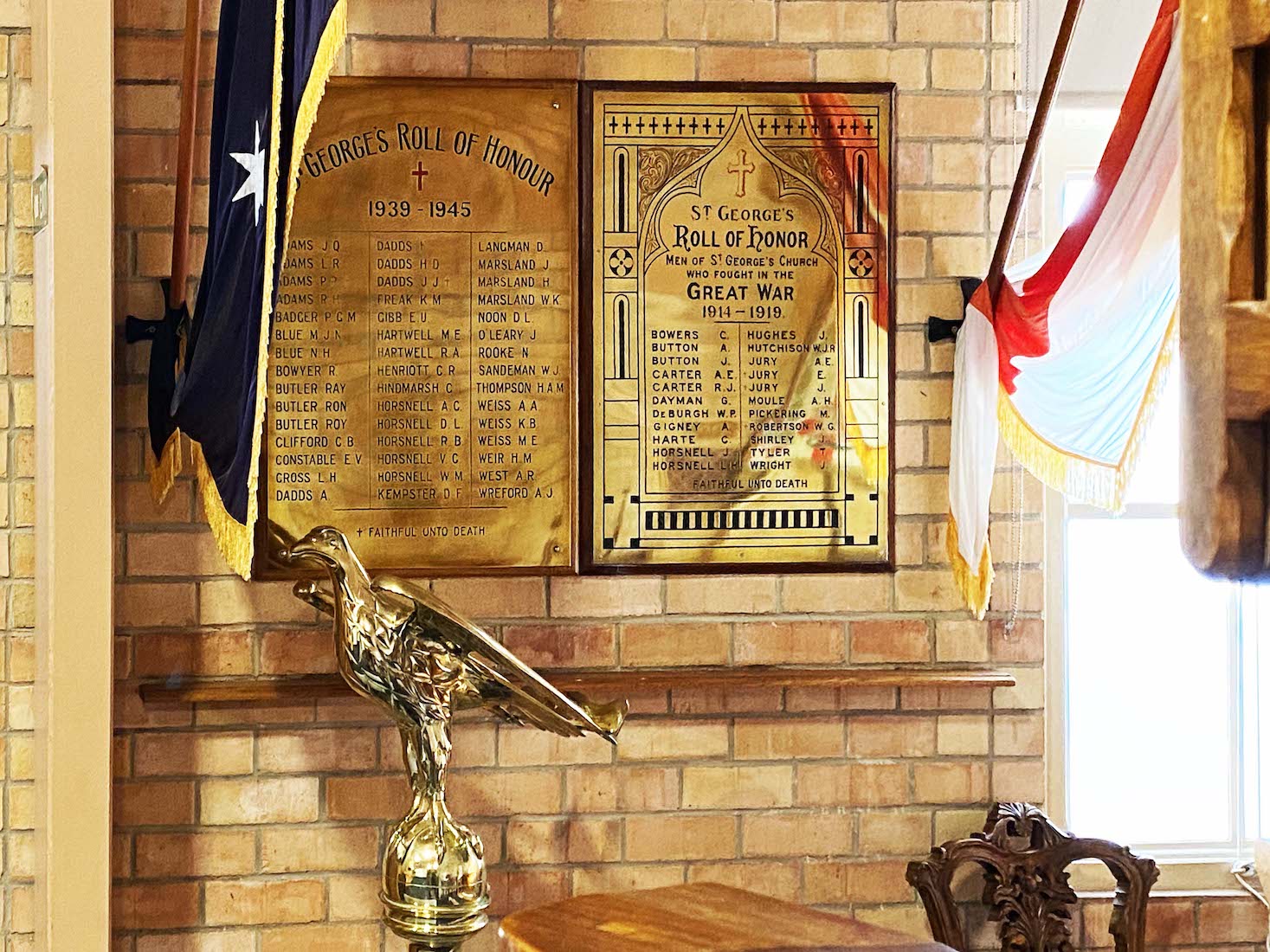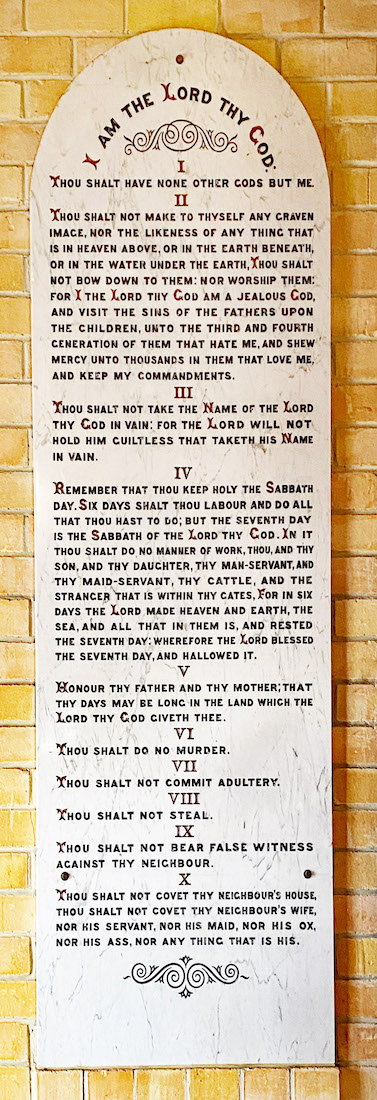20. APPROACHING THE SANCTUARY


We are now at the front of the nave, and can take time to appreciate the Eastern part of the Church From here we can see into the North porch (top view, left)
23. PULPIT AND FONT
Just North of the sanctuary stand the pulpit and the baptismal font. •• The pulpit, made of Tasmanian Blackwood, was given as a memorial to the men of Magill and Tranmere who fought in the First World War. It has some small carvings showing grapes on vines. It is from here that the Gospel is preached week by week. •• Close by is a small baptismal font, with a nicely carved wooden canopy. This font, made from Caen stone in France, was donated to the Church by The Hon. John Baker MLC one of the first Trustees. He gave the font as a thank-offering for the escape from assassination in Sydney of Prince Alfred, Duke of Edinburgh, who was a personal friend of the Bakers. •• We now walk across to the North porch.

This interesting window, depicting Jesus preaching, and inscribed ‘COME UNTO ME ALL YE THAT LABOUR AND ARE HEAVY LADEN AND I WILL GIVE YOU REST’ (Matt 11:28), was a gift by Mr and Mrs William Robert Swan in 1883 during a refurbishment of the Church. It was made by the world renowned firm of Albert Powell of 30 Park Square, Leeds, England. The window was originally placed in the Eastern wall of the original chancel flanked by the two marble tablets now in the Side Chapel.
25. PHOTO WALL OF PORCH
The East wall of the porch is a photo wall: a record of the past priests at St George’s. Two fairly indecipherable plaques are on the wall below.
26. PAUL HUNT PHOTO
Rev. Paul Hunt was Rector of St George’s Church from 2006 until 2017. For the photographs on the East wall, check here.
27. PLAQUE AND PLATE
When people design plaques, I do wish they would give a thought to the future! •• Text of left plaque: ‘ST GEORGES CHURCH // SESQUI-CENTENARY // THE FOUNDATION STONE WAS LAID ON // 18 JANUARY 1847 BY MRS FREDERICK BAYNE // 150 YEARS LATER ON 19 JANUARY1997 // THE CEREMONY WAS RE-ENACTED’ •• The text of the right plaque: ‘THIS FOUNDATION STONE WAS LAID ON THE // 18TH JANUARY, 1847 // BY // MRS FREDERICK BAYNE OF STRADBROKE // AND RELAID ON THE 8TH FEBRUARY, 1959 // BY // MR C. WARREN BONYTHON’.
28. TO THE SIDE CHAPEL
Leaving the North porch, we walk to the left of the pulpit into a small chapel. This has been described as the Lady Chapel, but I can find little indication (one plaque!) of this in the Chapel itself. To the left there is a brass eagle lectern, flags of Australia and England, and several brass plates on the wall. Facing us there are two marble tablets on the wall, and altar with an open Bible and two candlesticks, with a cross above. We can just see a banner leaning against the wall at right. In this photo we also see a brass water jug tucked beneath the pulpit – obviously associated with the font.
29. EAGLE LECTERN
The eagle lectern has a traditional design, and is of the type often found in Anglican churches. It is used to display a copy of the Bible for reading out to the congregation in Sunday services. Why the eagle? Several explanations have been offered (the eagle flies highest to heaven, Isaiah 40:31 – they will fly with wings as eagles, the eagle being the symbol representing St John the Evangelist), but I find none of these convincing. Perhaps the best answer is church tradition!
30. HONOUR ROLLS
On the wall behind the lectern are the flags of Australia and England, and two brass Honour Rolls.
31. HONOUR ROLL DETAILS
The Honour Rolls list the names of congregational members who gave their lives in the two World Wars. I assume the crosses distinguish between those who were killed in action, and those who died later from wounds received.
32. SIDE CHAPEL
Moving closer to the chapel altar, we notice the two Glastonbury chairs, the kneelers on the floor,and the full extent of the St George’s banner. Also, the white stone below the cross appears to be a Tudor rose.
33. CHAPEL TABLETS
The tablets on either side of the altar are shaped as one might imaging the tablets given to Moses. The left tablet has inscribed on it The Lord’s Prayer at top, and the Apostles’ Creed below. The Apostles’ Creed, though not written by the apostles, is the oldest creed of the Christian church and is the basis for others that followed. •• The right tablet bears the words of The Ten Commandments.
34. BRASS AND BANNER
At the East end of the Chapel, we have a brass plaque facing in on the North side, and the banner to the right. •• The plaque is in memory of Alfred Honner who was Honorary Canon of Adelaide and Rector of this Church for 37 years. He died in 1909 aged 75 years. •• The banner has the heading ‘St George’s Magill’, and shows St George slaying the dragon. St George was an early Christian martyr who was a soldier in the Roman army. He was sentenced to death in 303 for refusing to recant his faith. The most famous story about St George is his encounter with the dragon, although The Catholic Encyclopedia states that ‘no faith can be placed in either the details of his history or his alleged exploits’! I like St George!
35. CHAPEL ALTAR
The Chapel altar is a simple wooden structure with the text + HOLY + HOLY + HOLY + inscribed across the back.
36. CHAPEL CROSS AND ROSE
On the wall behing the altar is a brass cross with an interesting shape – between an arrow cross and a fleury cross. Below is a broken carved stone – a Tudor rose as we shall see shortly.
37. CHAPEL KNEELERS
On the floor in front of the altar are a couple of special kneelers – part of a larger set, handmade by the ladies of the Church. The patterns here show that this was part of a Church centenary project undertaken by ladies of the Mothers Union.
38. GLASTONBURY CHAIR
In the Chapel are two Glastonbury chairs. ‘Glastonbury chair’ is a nineteenth-century term for an earlier wooden chair, usually of oak, possibly based on a chair made for Richard Whiting, the last Abbot of Glastonbury, England. They have distinctively shaped arms, and carry the IHS symbol (the first three letters of the name ‘JESUS’ in Greek).



























